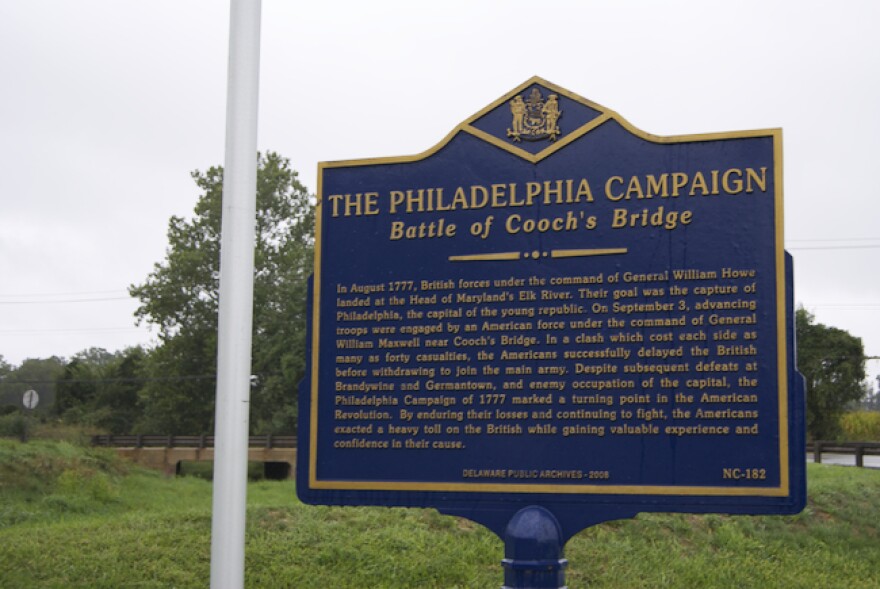While the state of Delaware and the new Friends of the Cooch’s Bridge Historic Site develop their plans to interpret centuries of history at the property near Newark, the inescapable reality is that the Revolutionary War battle there will remain “the number one draw for the site,” says Richard Cooch, a retired Superior Court judge and the ninth generation of his family to live in the 270-year-old homestead.
The battle, on Sept. 3, 1777, was the only combat in Delaware during the Revolution and the engagement marked the start of the British army’s Philadelphia campaign – a monthlong drive of British and Hessian troops that began in Elkton, Maryland, and proceeded, after Cooch’s Bridge, north through Hockessin and on to the Battle of the Brandywine in Chadds Ford on Sept. 11. By Sept. 26 the British had taken over Philadelphia – sending the Continental Congress west to Lancaster, Pennsylvania, where it met for one day, and on to York, Pennsylvania, where it met until June 1778. The succession of defeats pushed George Washington’s Continental Army into its encampment at Valley Forge, Pennsylvania, for a bitter winter.

About 1,700 British and Hessian soldiers marched from Elkton into Delaware, roughly following today’s U.S. 40, then turned north at Glasgow and headed toward Iron Hill and Cooch’s Bridge. Defending the area was a newly formed light infantry corps of about 800 men, led by Brigadier General William Maxwell of New Jersey. Outnumbered by roughly two to one, Maxwell’s unit could not stop the British advance, but it did slow down the enemy. Contemporary descriptions labeled the battle, which lasted more than 7 hours, “bloody” and “severe.”
“It was a very intense engagement,” says Wade Catts, a historical archaeologist serving as an advisor to the newly formed Friends of the Cooch’s Bridge Historic Site. Official reports state that 24 of Maxwell’s men and four British soldiers were killed, with 40 wounded on each side, but Catts suspects that the British underestimated their casualties.

Catts and Cooch say that the soldiers killed in the battle are buried in the area, but they are not sure where. “It could be anywhere from Sunset Lake up to the bridge,” Cooch says. “It’s hallowed ground.”
Several members of Maxwell’s unit would go on to significant careers in the military and public service, the most notable being John Marshall of Virginia, who became the fourth chief justice of the U.S. Supreme Court, serving from 1801 to 1834.
The battle spawned several stories, most notably the claim in the 1890s that the Stars and Stripes were first flown in battle at Cooch’s Bridge. That legend took root, Catts says, based on an article published by a Wilmington newspaper editor named Watson Sperry. To advance his claim, Sperry convinced J. Wilkins Cooch, who owned the homestead at the time, to erect a large flagpole in front of the house.
(For what it’s worth, the Wilmington Evening Journal of May 7, 1898, described J. Wilkins Cooch as “the only man in Delaware who owns his own battlefield.”)
Richard Cooch says his father, Edward W. “Ned” Cooch Jr., believed the flag story, often asserting at talks he would give that “if it wasn’t flown first at Cooch’s Bridge, then where?”
But Catts and Richard Cooch are skeptical. Other sources claim that the first time the Stars and Stripes flew in battle was at the Battle of the Brandywine. The argument in favor of Cooch’s Bridge, Cooch says, is derivative: “They say the same soldiers that fought at Brandywine fought at Cooch’s Bridge, so the flag must have flown there first.”
“Most flag scholars would say that the American flag didn’t really get a confirmed usage until the 1820s, but it’s an important part of the Cooch’s Bridge historiography that the American flag was there,” says Vince Watchorn, president of the Friends group. “We don’t have any solid evidence except that people have said it was there.”
The flag story, Cooch suggests, isn’t nearly as significant as the battle. “If it’s true, it is. If it’s not, it’s not,” he says.
Cooch can offer another story that he suggests is more definitive – the identity of the battle’s last casualty.
In 1996, at his home in New Castle, Cooch’s 10-year-old son, Rich, was playing with a cannonball that had been found years before on the battlefield site. “He dropped it on his foot. He got an angry red bruise. We took him to the emergency room. There were no bones broken and the pain went away, but the doctor couldn’t believe he was struck by a cannonball from a Revolutionary War battle.”




